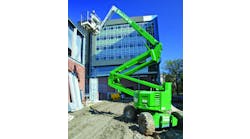Although a few rental companies said 2008 was a good year, it will come as no surprise that the majority found business slowing down, especially in the latter months. Most feel 2009 will be even more difficult, with fewer construction projects, and a lot of over-fleeted competition slashing rates to keep machines utilized.
Business seemed strong in most of Texas, and some companies in Louisiana were still reaping the bounty from post-hurricane rebuilding efforts. Areas strong in mining and energy-related industries fared pretty well in 2008 and expect solid business to continue in 2009. There were other pockets of strength amid the overall slowdown.
Times were particularly tough in areas hit hardest by the slowdown — or virtual halt, depending on who you talk to — in housing construction. Commercial construction, while still reasonably strong in early 2008, finally began to catch up in the latter half of 2008.
One doesn't have to be an economist to see that 2009 will be challenging to say the least. But the rental industry, like any business, is not for the faint of heart, and people still need to make a living and go to work every day with hope. Rental company executives have learned from previous recessions that there is a lot one can do to keep their businesses running profitably, and downturns can be a good time to put changes in place that will help when things begin to turn up again, whether that be later in 2009 or 2010 or even beyond.
That experience keeps the outlook optimistic for many.
“Downturns are good in that they force a good business to realize its strengths and focus on the basics,” says Joel Theros of Theros Equipment, Gainesville, Va. “During a hot economy, it is easy to be tempted and try to be everything to everyone. This causes the need for additional overhead and personnel. A downturn corrects all of that.”
RER spoke with rental company owners around North America about their strategies for profitability — or at least survival — in 2009. Here are 25 tips we uncovered that might help in the coming year. You won't be able to incorporate them all because there are many different approaches and what might work for one rental company is likely to be the opposite for another. No matter. If even one of them works for you, it will be worth the time it takes to read the article.
- Boost your sales staff
While adding employees is the opposite of what most rental companies are doing in 2009, many rental company owners say increased sales and marketing is more vital than ever when business slumps.
The theory is basically simple. If your company is bringing in 10-percent less revenue, with that 10 percent coming from the same amount of customers, you may be able to make up the difference by adding new customers. You need more sales staff to reach those new prospects. A few good new accounts will likely pay for those new people, whose responsibilities could be to build rental, beef up equipment sales or both.
Seattle-based Star Rentals added new sales staff and made them more efficient with several regional sales manager positions to “create more focus on targeting key accounts, and grow business with those key accounts,” says CEO Bob Kendall. “Slow periods give you an opportunity to slow down the focus. This is the most organized we've ever been in our outreach. We've stepped up our marketing and been more aggressive.”
- Dial for dollars
While some rental company executives say telemarketing campaigns are outdated, several rental companies are experimenting with them. One way is to develop a script and get on the phone calling prospects to let them know about what your company can offer.
Another method is calling to gauge customer satisfaction, asking the customers if they were satisfied with recent service provided by the rental company. If the customer was satisfied, it's a good way of reminding them your rental company is still out there next time they have a rental need. If they weren't satisfied, it's a good way to find out why, for the benefit of improving the company as well as letting the customer know you are concerned and hope they'll give your company another opportunity to prove itself.
- Be a riverboat gambler: Expand.
To the vast majority of rental companies as well as other businesses in recessionary times, the instinct is to retrench, cut back on employees, services, hours of operation, and expenses in general. To others, it's time to expand to new territories or offer new services. Some say they believe in this philosophically but simply cannot afford to do it, although they can make plans for future growth.
Ron Pikulik, rental manager for Chicago-based Patten Industries, says his company is “in the process of creating a four-year business plan that will propose expansion.” While Patten may not be ready to embark on the venture now, it's at least putting the plans in place. Other rental companies, such as Star Rentals, are planning 2009 expansions.
Some companies, such as Dulles, Va.-based Capital Rentals, Knoxville, Tenn.-based Stowers Rents, Birmingham, Ala.-based B&G Equipment, and Phoenix-based Sunstate Equipment, expanded their market share by opening new branches in 2008.
“In preparation for the downturn, we expanded geographically and increased our marketing staff,” says Ken Pustizzi, CEO of Trico Lift, Millville, N.J., which opened new branches in Houston and Plainville, Conn., in 2008. Some companies, while not expanding geographically, have added lines or placed greater emphasis on particular product segments, such as Bristol, Pa.-based Modern Group, which has amped up its power generation segment. Capital Rentals expanded its high-reach fleet in 2008.
Sometimes a change in customer focus or attention to a new customer segment can bring in new business and revitalize operations. “We restructured our business units, looking more to industrial and non-jobsite customers,” says Modern CEO Dave Griffith.
“To expand our business, we have set up rental operations at our Reserve dealership and have built a new stand-alone facility in Baton Rouge,” adds Jay Dinger of Louisiana Machinery, Reserve, La. “Also, we have purchased property in Covington, La., and will build a new rental facility with construction to begin in early 2009.”
- Get rid of underperforming assets
Probably the most oft-mentioned suggestion by those interviewed for this article, selling off underperforming equipment, either directly through ones' own retail efforts, through auction or broker, reduction of underperforming inventory is almost universally agreed upon as a sure-fire recession strategy.
- Buy used equipment
As the majority of rental companies attempt to reduce their fleet, now is a great opportunity to buy late-model equipment at good prices. One company, Sugar Grove, Ill.-based Metrolift, is taking advantage of the opportunity by hiring a used equipment specialist to help beef up its fleet. “He'll be looking at late-model deals,” says CEO Rick Dahl. “We're upgrading the bottom end of the fleet. We're transitioning out about 100 to 150 machines so we're hoping to upgrade in those areas.”
Does this tip contradict the previous one? Not at all. By all means, rid your rental company of underperforming assets, but, if possible, beef up on equipment that has a good chance of being properly utilized.
- Special offer
When iron isn't moving, manufacturers tend to offer deals too good to pass up, such as no interest payments for the first year of ownership. The ARA Rental Show will be a good opportunity to see what kind of terms manufactures are offering.
“We're being more careful on investing, seeing which investments would bring a higher return, analyzing more carefully how assets will be utilized” says Joe Phelon of Timp Rental Center, American Fork, Utah. “In recent years, we'd swing at any pitch, and usually manage to get a hit, but now we are being more selective on which pitches we swing at. We can't afford to swing and miss. We won't swing on pitches we're not sure about.”
A lot of companies are analyzing inventory more carefully. “We're going to watch our capex,” says Ron Shelton of Houston-based National Trench Safety. “We're not going to pre-buy like we often do, but if we do see an opportunity, we'll consider it. This may be a great time for possible expansion; vendors are all hungry, ready to make deals. There are deals you couldn't make six months ago.”
- Increase dealership activities
Some rental companies, such as B&G Equipment and Washington Air Compressor Rental Co., Hyattsville, Md., have added dealerships and added an increased emphasis on dealership activities at their rental businesses. Aftermarket support and parts sales can be strong revenue sources and can keep customers focused on your business as a one-stop shop for their equipment needs.
“Being able to develop relationships in a down market through product support builds opportunity for rental and sales in better times,” says Stowers Rents chairman Wes Stowers.
- Rentals only please
For Joel Theros of Theros Equipment, the opposite strategy makes more sense. “In 2008, we discontinued our dealership activities,” says Theros. “In 2009, we will be 100 percent rental. The discontinuation of the dealerships has afforded us some cost-cutting and allowed us to focus on our more profitable rental activities. We feel that a 100-percent rental position is a simplification that will poise us for continued growth. In 2009, we intend to develop and grow as a 100-percent rental company and continue to seek operating efficiencies while sticking to the basics of good service.”
- Do you read me? Over?
Although the decrease in the cost of fuel might have taken some of the urgency out of improving dispatch systems, many rental companies are still looking to improve dispatching through a variety of new systems currently on the market. For multi-location companies, centralized dispatching systems can significantly improve efficiencies, reducing multiple trucks redundantly crisscrossing territories, reducing deadheading time, shortening delivery pick-up time and deploying service personnel's time more efficiently.
- Bar coding
Companies such as Patten Industries and Louisiana Machinery are among many to launch the use of bar coding to more efficiently track incoming and outgoing equipment. While this technology has been on the rental horizon for several years, it is now catching on to more widespread use.
- GPS/Telematics
“The use of GPS for mileage savings, interconnectivity to vans and broadband access, and the ability to connect all the service men in the field will be a huge efficiency boost,” says Modern's Griffith. Many manufacturers are now offering built-in telematics systems as adoption in the rental market becomes increasingly widespread.
- Electronic billing
Electronic billing is becoming an important time and cost saver for many rental companies. While a few years ago this was more customer driven, with a “we'll wait for our customers to request this,” attitude on the part of many rental companies, now the ability to cut down on paper and postage expenses as well as the time it takes to send something through the mail as opposed to via e-mail is leading many rental companies to develop electronic billing systems. Increasingly, customers also appreciate the cost-cutting aspects of electronic billing. A growing appreciation for environmental sensibilities is also driving this trend. The ability to create an electronic trail is also a plus, reducing the need for extensive paper filing.
Buying certain items, such as parts, can also be more efficient online, and electronic parts procurement systems, such as SmartEquip's, can save time, energy and significant sums of money.
- 90 days and counting
Receivables need to be watched carefully in any economic cycle, but particularly during recessions. Rental companies are already seeing a lengthening of payment cycles and several are finding that close communication with customers helps alleviate this process. As one said, “Most of my late-paying customers are honorable and don't like being behind on their payments to us any more than we like them falling behind.”
Like it or not, a proactive approach is necessary. “We try to get involved at an earlier phase,” says Trico Lift's Pustizzi. “We tell customers that if they think they might have payment problems, to give us an early warning to help them figure out solutions.”
- Reduce headcount
We hate to suggest it, but a lot of companies are doing it right now, and it's a common strategy in downturns. Some cut by seniority, others by determining the most productive people. “We trimmed our force by about 10 percent, and it made us take a hard look at our staff and the strengths and weaknesses of each person,” says Jack Greenfield of Tacoma, Wash.-based Bunce Rentals. “We cut a lot of fat and I think we're a better company for it. It demonstrated to the managers that they could run lean and mean. If you tell managers they have to lay off X number of people they're like ‘Oh man, how am I going to be able to operate like that?’ Well, guess what, you can.”
- Increase headcount
Paradoxically, it also makes sense to add people, particularly in the area of marketing and sales. “Some competitors have closed stores and that has presented opportunities for us,” says Nick Mavrick, communications executive for Volvo Rents. “Staff reductions by others makes some staff available; we've come upon some fantastic people who did not have non-competes. If an over-leveraged national company de-leverages, they put talent back on the market.”
“Labor is one of the hardest expenses we have to manage and one we in the rental industry probably do the worst job with,” says Dean Eklund of Lew Rents, Olympia, Wash. “During good times we say we can't find good people, during bad times we let them go!”
- The dashboard doesn't lie
In Major League Baseball, Albert Pujols won the National League's Most Valuable Player Award. If you didn't watch him play regularly, how do you know he deserved it? Measurements, otherwise known as statistics, tell us. Pujols hit .357, with 37 HR and 116 RBI, with an onbase-plus-slugging percentage of .1115. We have those staggeringly successful measurements plus the word-of-mouth awareness that he's a good team guy and a fine defensive player.
So how do you know if your service calls are timely enough, if your compliance with preventive maintenance schedules has improved, if your deliveries are quicker, if the percentage of your fleet that's in the shop has decreased? You measure them. Figure out the standards you want and measure your progress.
“We measure on-time delivery, compliance with service, various other metrics and we're re-structuring operations so our strategy is in line with those measurements,” says Metrolift CEO Dahl.
- Go green
Not only are environmental considerations the right thing to do in terms of preserving the environment, but there are great economic benefits. One can start by reducing paper in the operation of a rental company, looking into electronic billing and other cost-preservers. One can apply green principles in the solvents and oils and materials used in the rental shop, and many manufacturers are designing equipment to be more environmentally friendly.
And in the coming years, more rental customers will prefer to do business with suppliers adhering to green principles. Just as many customers want documentation of a rental company's safety record, in the coming years it is likely customers will want to see documentation of a rental company's environmental compliance. Metrolift's Dahl says already some Chicago-area contractors in certain segments are moving in this direction.
- Think small
SUVs and pick-up trucks are usually the vehicle of choice for rental sales specialists. While they might come in handy negotiating the back roads of rugged and remote jobsites, some rental companies are finding them to be an unnecessary expense when fuel-efficient smaller cars can often get staff where they need to go just as effectively. The price of fuel has come down recently, but which way will it go in the coming years?
- Promote and train
Rental companies looking to fill positions often will try to hire people away from other companies. But your solutions might lie within your own already-trusted employees. All they lack is training.
“Our industry needs more leaders, so we have to help develop them,” says Ken de Vries of All Star Rents, Fairfield, Calif. “Our industry has relied too much in going outside for promotable people rather than developing them ourselves. A lot of good people leave our industry; we need to keep those people by giving them opportunities.” De Vries started a leadership training program at the beginning of this year, focusing on continuing education.
-
All Star's training includes classes, seminars, volunteer work and community service, and reading books. It covers financial training, human resources training, administration and more. The company is training lead mechanics, managers, sales staff, lead drivers and others who can use new skills to lead and train others.
“The leadership team of the company is developing the program and those on the leadership team will mentor the trainees and monitor their progress,” adds de Vries. Training will include on-the-job exercises such as riding with a sales person, partnering with mechanics, visiting branches and doing SWOT analyses. College classes in topics such as Spanish, accounting or welding could be part of the program, which each mentor designs for each particular participant.
Kropp Equipment, Schererville, Ind., developed an online training program so its sales staff at the company's four locations could participate without traveling, offering four-hour sessions once a week. “It's back to basics, but it goes on to mid-level, upper-level and doctorate degree in sales,” says owner Al Kropp. “We all learn from it. I've got friends who are doctors who go to seminars a few days a year. We forget some of the basic education that brought us to our current level. This takes us to the next level and stirs up some excitement.”
- Sell equipment internationally
If not happy with the prices you're getting for your used equipment — and with scores of U.S. rental companies competing to unload unwanted assets, many face the same problem — try selling them internationally. Metrolift, for example, recently sold 32 aerial work platforms to South Korea.
One of the attractions of selling internationally is to remove your divested machines from your market so they can't compete against you. Illini High Reach, Lemont, Ill., regularly sells its used equipment abroad. “I consider it a success when we sell it, make some money at it and it leaves our market,” says Illini CEO Larry Workman. “Louisville is fine; Singapore is better.”
While the international used equipment market can be lucrative if done properly, every country has different regulations, and even different machines going into the same country can be subject to different taxes or permits. Export specialists or international equipment brokers such as Glen Ellyn, Ill.-based Universal Equipment should always be consulted.
- Far from home
Delivery costs money and delivering long distance even more money, but equipment sitting in a yard does no good at all. Some rental companies are bidding on jobs far away from their market areas.
For example, Black Swamp Equipment, Archbold, Ohio, is looking at jobs all over the country. “We'll go great distances,” says Black Swamp's Jeff Fryman. “We'll go out of state if we have to. We've got stuff quoted in Phoenix, in Mississippi, Louisiana, Florida and elsewhere.”
- What's renting?
Improving volume can be as simple as asking that question. While the market may have slowed down, another factor could be that your customer base is changing.
“A few years ago, the top 10 of our customers were all new home builders,” says Don Bruner of Cincy Tool Rentals, Cincinnati. “Now they are highway contractors, remodelers, rehab people, roofing contractors, landscapers. So we lessened our pump and generator inventory and beefed up other items.”
- Lobby for an infrastructure package
RER asked dozens of readers what message they'd like to send to the new Obama administration and the response was almost unanimous: Pass an infrastructure spending package. If the health of the industry and your rental business depends on it, it's worth spending a few minutes a day, even in these demanding times, to make phone calls, write Congress people or whatever form of political participation you feel is most effective and make sure elected officials get the message.
“Infrastructure is the No. 1 job creator,” says Modern Equipment's Griffith. “So I'd love to see an infrastructure bill. We need roads, we need highways. Spend the dollars on rebuilding the country; invest in alternative energy.”
- Drop-off depots
Setting up a new facility in an area where your rental company is doing significant business can be expensive and even cost-prohibitive in the current economic environment. But if you're doing a lot of business in an area far from a branch, what about leasing some property to use as a drop-off and storage point for equipment? It can significantly save in time and fuel costs and make it easier to serve customers in that area, and possibly pave the way for opening a branch in that area later on. Some rental companies do this in cities that might be an hour or two away from headquarters; others based in large, spread-out metropolitan areas do this if they are doing a lot of business in an area an hour or two away, cutting fuel costs and lessening wear and tear on vehicles forced to travel long distances in heavy traffic.
- Form a committee
It may take more than just one head to figure out how to cut expenses. Star's Kendall formed a special committee to figure out how to cut expenses. More important, now more than ever, serious market analysis is needed to figure out how to respond to current challenges. A group approach can help, bringing together different points of view from various facets of your company.





